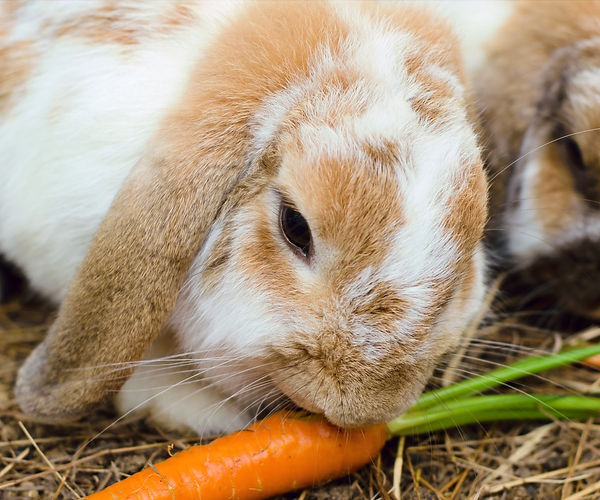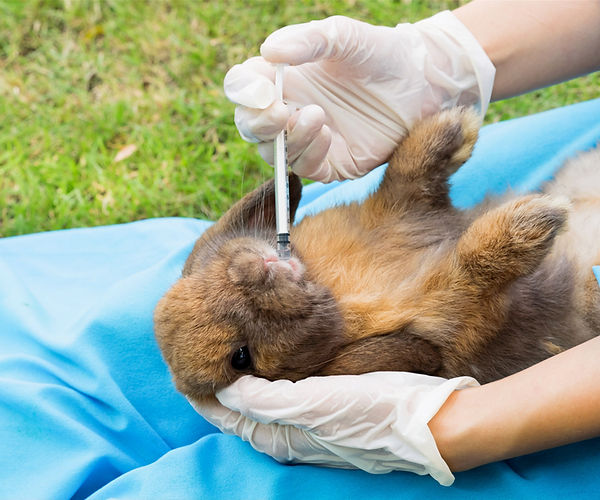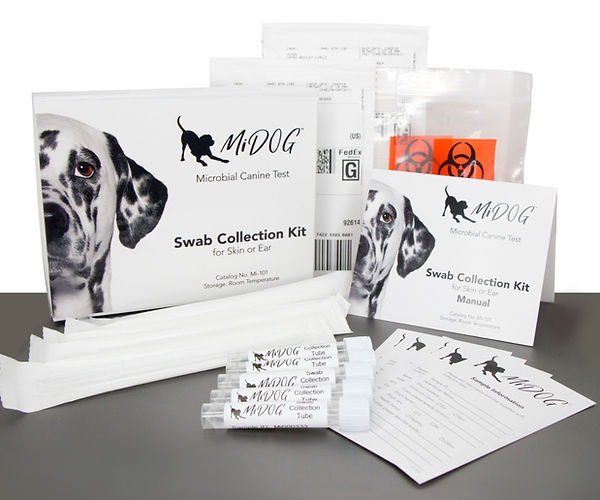
Hare me out—your lop-eared rabbit may be the cutest creature to hip-hop on this planet, but those floppy ears require special attention! If your bunny seems to be tilting their head and losing their balance, they may have an ear infection and need to visit an exotic pet veterinary specialist. Morphological differences between lop-eared rabbits versus wild-type straight-eared rabbits (caused by breeding preferences for floppy ears) account for the increased rates of cranial health issues in lop-eared rabbits [1]. This ranges from ear infections to even dental problems. Ear infections are painful and if left untreated can potentially result in deafness, and so early identification and intervention are beneficial.
Why Do Lop-eared Rabbits Have More Aural Health Problems?
Or rather, let’s start with why do some rabbits have floppy ears in the first place?
The “father of evolution” Charles Darwin was the first individual to document this floppy evolutionary occurrence, noticing that lop-eared rabbits (rabbits with pendulous pinnae) concurrently had notable deformation of their skull that impacted where the auditory meatus meets with the tragus [2]. Selection amongst breeders for lop-eared rabbits in the 19th century was commonplace, and a hallmark example of artificial selection [2]. Since then, scholars have refined theories to account for the inadvertent byproduct of breeding selection for lop-eared rabbits, with the phenotypic accommodation theory surfacing as the popular theoretical framework for this unique morphological byproduct. The phenotypic accommodation theory addresses instances in which one trait undergoes selection for a morphological change, and as a consequence, a neighboring trait may change as a result of the trait’s “structural relatedness” [3]. And so selection for increased ear length has actually changed the shape of lop-eared rabbit external auditory meatus, which is the bony tissue that supports the cartilaginous external ear [3].
This selection has gone on to create nine different domestic lop-eared rabbits, with lop-eared rabbits now representing up to 57% of the types of rabbits bred in England [1]. Moreover, lop-eared rabbits composed approximately 58% of the breeds advertised on a popular UK free pet website [1]. Ironically, despite breeding and advertising preferences suggesting a consumer bias for lop-eared rabbits, a recent study assessing human preference on “what makes a rabbit cute?” found that erect-eared rabbits are actually considered significantly cuter [4].
Irony aside, selection for lop-eared rabbits has resulted in increasingly narrow ear canals, which reduces airflow and obstructs the expulsion of earwax [1]. The accumulation of earwax provides the ideal breeding ground for opportunistic microorganisms and consequently predisposes lop-eared rabbits to otitis externa, otitis media, and otitis interna; in other words, lop-eared rabbits are more likely to suffer painful ear infections. Bacterial microorganisms such as Pasteurella multocida, Staphylococcus aureus, Pseudomonas aeruginosa, and Streptococcus spp have been found to be associated with otitis manifestation in lop-eared rabbits [5]. Additionally, Psoroptes cuniculi mite infestations also cause otitis externa [1].
What Symptoms Should I Look For My Lop-eared Rabbit’s Ear Health?
Recognizing the warning signs of potential ear infections is important for any lop-eared rabbit owner. Presentations of otitis (inflammation of the ear) exist on a spectrum, and can be acute but also chronic. Here are some symptoms to be on the lookout for:
- Head and/or ear scratching
- Head shaking
- Loss of balance
- Loss of appetite
- Pain and irritation around the affected ear
- Sudden loss of balance, dizziness

A lop-eared rabbit visits their exotic pet veterinarian.
If you think your rabbit may have an ear infection, the best thing you can do is get a quick and accurate diagnosis from your rabbit veterinarian as soon as you notice symptoms. If the infection is bacterial, getting started on an antibiotic treatment plan tailored to the severity and strain of your rabbit’s ear infection is important [6]. Antifungal medications or anti-parasite injections will be administered if the infection is caused by either yeast or mites, respectively. In severe cases, your rabbit may need hospitalization and even surgery.
Diagnosing Ear Problems in Lop-eared Rabbits
Considering the importance of understanding the severity of your rabbit’s ear infection, diagnostic tools are critical in delivering quality clinical care. Although culture-based tests have historically been lauded as the convention for ear infection diagnosis, scientific research has provided increasing evidence for the diagnostic benefits of Next-Gen Sequencing (NGS) technology. Conventional culture-based tests have significant limitations in sensitivity to various microorganisms, as many remain undetected by culture methods [2]. Specifically, Gram-negative bacteria like Pasteurella multocida are challenging to culture and can result in “no growth” cultures despite symptomatic ear infection presentations [2]. This is particularly problematic in cases of antibiotic-resistant strains of opportunistic pathogens, and so having the diagnostic knowledge to assign appropriate medical intervention is key [6].
The MiDOG All-in-One Microbial Test utilizes NGS technology to detect and quantify microbial DNA through untargeted and comprehensive sequencing and quantitative comparisons to reference databases. The MiDOG NGS technology provides a useful opportunity to shed light on the microbial makeup of your rabbit’s ear for clinical application [7]. The MiDOG microbial test is grounded on scientific research that provides veterinarians DNA evidence for the guided treatment of rabbit ear infections, such as otitis. A MiDOG microbial test provides the technologies for the accurate identification of all microorganisms within a pet’s sample, independent of culturing.

Find out if your vet uses MiDOG before you book your next appointment!
For health-related questions about your rabbit or other exotic pet, reach out to a veterinarian that specializes in exotic pets.
References:
[1] Johnson, J. and Burn, C., 2019. Lop-eared rabbits have more aural and dental problems than erect-eared rabbits: a rescue population study.
[2] Cordero, G. and Berns, C., 2016. A test of Darwin’s ‘lop-eared’ rabbit hypothesis. Journal of Evolutionary Biology, 29(11), pp.2102-2110.
[3] West-Eberhard, M., 2005. Phenotypic accommodation: adaptive innovation due to developmental plasticity. Journal of Experimental Zoology Part B: Molecular and Developmental Evolution, 304B(6), pp.610-618.
[4] Harvey, N., Oxley, J., Miguel-Pacheco, G., Gosling, E. and Farnworth, M., 2019. What Makes a Rabbit Cute? Preference for Rabbit Faces Differs according to Skull Morphology and Demographic Factors. Animals, 9(10), p.728.
[5] Fisher, P. and Carpenter, J., 2012. Neurologic and Musculoskeletal Diseases. Ferrets, Rabbits, and Rodents, pp.245-256.
[6] Vennen, K. and Mitchell, M., 2009. RABBITS. Manual of Exotic Pet Practice, pp.375-405.
[7] Hall, J., Holmes, M. and Baines, S., 2013. Prevalence and antimicrobial resistance of canine urinary tract pathogens. Veterinary Record, 173(22), pp.549-549.
